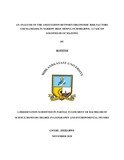Please use this identifier to cite or link to this item:
https://cris.library.msu.ac.zw//handle/11408/3612Full metadata record
| DC Field | Value | Language |
|---|---|---|
| dc.contributor.author | Maningire, Nyasha | - |
| dc.date.accessioned | 2019-05-06T13:02:21Z | - |
| dc.date.available | 2019-05-06T13:02:21Z | - |
| dc.date.issued | 2018 | - |
| dc.identifier.uri | http://hdl.handle.net/11408/3612 | - |
| dc.description.abstract | The main aim of the study was to analyse the association between ergonomic risk factors and illnesses in narrow reef mining at Goldfields of Mazowe (GFM).The analytical research design was employed and cross verification was done through combining several methods thus triangulation were both qualitative and quantitative research approaches were used. Data was collected through the use of interviews, questionnaires, field observations using Rapid Entire Body Assessment (REBA) and secondary data sources. Excel and statistical Package of Social Sciences (SPSS) were used to analyze the data statistically and the data was presented through the use of graphs, pie-charts as well as chi-contingency tables. The research discovered that of all the ergonomic illnesses GFM workers are mostly affected by chronic back aches. This is attributed to confinement, long ore movement distances, awkward drilling postures, as well as high reliance on manual labour since mechanization is used to a lesser extent due to limited space. Amongst the ergonomic risk factors awkward positions and repetitive use of body parts affected workers significantly affecting 91% and 93% respectively and all the underground workers affected on the back with some affected on their arms, hands and legs. It was established that the body parts affected are not dependent on the occupation following a dependence chi-square test done between body parts affected and the occupation performed this implies that everyone working underground is at risk regardless of occupation because of the set-up of the mine. Besides the nature of workplace there is insufficient recovery time due to more concentration on maximising production while ignoring safety aspects (relationship between worker and his work place). The occupational safety and health management system in Zimbabwe as a whole pertaining to ergonomic issues is less effective and improvement is required. Recommendations include mechanisation of underground operations, introduction of recovery time, launching value based safety programs, establishing and intensifying training on wellness programs, NSSA to formulate a clearly stated ergonomic policy and adopting the participatory methods by NIOSH ergonomic processes and risk factor awareness in mines. | en_US |
| dc.language.iso | en | en_US |
| dc.publisher | Midlands State University | en_US |
| dc.subject | Ergonomics | en_US |
| dc.subject | Ergonomic risk factors | en_US |
| dc.subject | Illnesses | en_US |
| dc.subject | Narrow reef mining | en_US |
| dc.title | An analysis of the association between ergonomic risk factors and illnesses in narrow reef mining in Zimbabwe: a case of Goldfields of Mazowe | en_US |
| item.grantfulltext | open | - |
| item.languageiso639-1 | en | - |
| item.fulltext | With Fulltext | - |
| Appears in Collections: | Bsc Geography And Environmental Studies Honours Degree | |
Files in This Item:
| File | Description | Size | Format | |
|---|---|---|---|---|
| final dissertation with all pages nyasha.pdf | Full Text | 1.24 MB | Adobe PDF |  View/Open |
Page view(s)
342
checked on Jan 10, 2026
Download(s)
256
checked on Jan 10, 2026
Google ScholarTM
Check
Items in MSUIR are protected by copyright, with all rights reserved, unless otherwise indicated.



